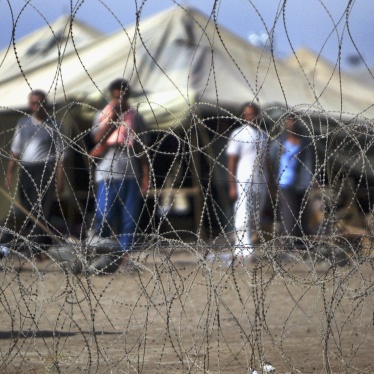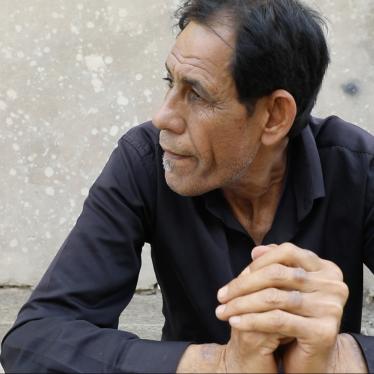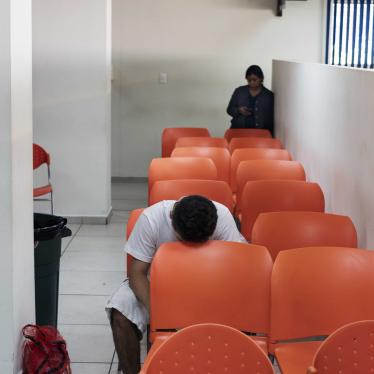Submission to the United Nations Committee against Torture
List of Issues Prior to Reporting – United States
59th session (November-December 2016)
Human Rights Watch welcomes the opportunity to contribute to the List of Issues Prior to Reporting of the United States in preparation for its sixth periodic review. The issues raised below focus on US National Security.
Investigation into Allegations of Torture
Since the Committee issued its Concluding Observations on the combined third to fifth periodic reports of the United States of America on November 28, 2014 (Concluding Observations),[1] the United States released a redacted summary of a long-awaited Senate Intelligence Committee Study of the Central Intelligence Agency’s detention and interrogation program (Senate Summary).[2] The Senate Summary corroborated information that nongovernmental organizations and the media had been reporting for years about the CIA program and disclosed new information about the program’s brutality and illegality.[3] Though release of the Senate Summary was an important step toward increasing transparency regarding the US use of torture and other ill-treatment since the September 11, 2001 attacks, it also underscored the degree to which the US has failed to comply with central obligations under the Convention against Torture and Other Cruel, Inhuman or Degrading Treatment or Punishment.
The US has not carried out adequate investigations into those responsible for authorizing or implementing the CIA program or into those who engaged in acts even beyond the illegal “enhanced interrogation techniques” that were authorized. In December 2015, Human Rights Watch extensively documented and analyzed the inadequacies of prior US investigations into CIA torture, challenging claims that that it was not legally possible for the Justice Department to prosecute.[4] We incorporated that analysis into our March 1, 2016 submission to the Committee assessing the US response to the Committee’s request for follow-up information pertaining to several recommendations in the Concluding Observations.[5] Since then, in response to Freedom of Information Act requests, the CIA released more information about the CIA program that disclosed further details about the program’s cruelty and illegality.[6]
Recommended Questions to the US
- Please address whether any limitations on evidence related to the CIA detention and interrogation program were placed on the members of US Attorney John Durham’s team investigating allegations of torture and other violations of US law? If so, what were those limitations?
- Acknowledging that during the November 2014 review a representative of the US delegation said that they were not at that time in a position to disclose certain information about any of the 96 witnesses interviewed for Mr. Durham’s investigation, could they please now provide information on whether any of the witnesses interviewed were former detainees in CIA custody? If so how many? What were the identities of the former detainees interviewed?
- Please provide information on the basis for the determination by Mr. Durham that many of the detainees whose cases he reviewed were not held in CIA custody and why it was decided that this limited the ability of prosecutors to investigate and prosecute wrongdoing.
- Please provide information on whether, in deciding to bring criminal charges for violations of US law in connection with acts carried out as part of the CIA program, the US considered jurisdiction under the treaty or US law to be a bar to prosecution? If so, in how many of the individual cases of abuse being investigated and what was the reasoning behind this decision?
- Please provide information on whether, in deciding whether to bring criminal charges for violations of US law in connection with the CIA program, the US believed that statutes of limitations were a bar to prosecutions? If so, for which criminal charges and why?
- Please provide details of steps taken, outside of prosecutions, to ensure that those responsible for CIA torture are held accountable.
- Acknowledging that during the November 2014 review, the US delegation made clear that obligations under the treaty apply to “all places that the State party controls as a governmental authority,” which includes the US Naval Station at Guantanamo Bay, and US-registered ships and aircraft, does the US consider detention facilities that the US operated as part of the CIA program to be within US jurisdiction for purposes of obligations under the treaty?
Redress
The United States is under an obligation to provide victims of torture with the ability to obtain redress, compensation and rehabilitation. In its last periodic report, the United States stated that a “wide range of civil remedies” exist for victims of torture to obtain rights relevant to the Convention.[7] Yet, not one former detainee who was in CIA custody has been able to enforce this right to a remedy in US court.[8] In April, the Justice Department did not invoke the state secrets privilege for the first time in a suit brought by former detainees for harm suffered while held by CIA.[9] But that suit involves only three plaintiffs, while scores of men held in the CIA program were tortured and ill-treated. Some of these men remain in US custody and are allegedly not receiving adequate medical and psychological care.[10] Many others are now out of US custody, were never charged by the US with any crime, and are trying—with great difficulty due to the trauma and injuries sustained in prolonged CIA incommunicado detention—to rebuild their lives.
Recommended Questions to the US:
- Please describe the specific means by which those subjected to torture or ill-treatment by the CIA as part of its “enhanced interrogation program” who have been released from US custody can obtain redress.
- Please describe the specific means by which those subjected to torture and ill-treatment by the CIA as part of its “enhanced interrogation program” who remain in US custody can obtain redress.
- Please provide details on the types of redress that have been provided to individuals held as part of the CIA program whether in or out of US custody.
- Please describe the specific medical treatment and rehabilitative care for prior torture or ill-treatment provided to former detainees of the CIA who remain in US custody.
Renditions to Torture
The CIA Rendition, Detention and Interrogation (RDI) program was not fully addressed in the Senate Summary. The Summary lists only the names of 119 individuals it considers to be “detainees” in that there was “clear evidence of detention in CIA custody.”[11] Left off the list are an unknown number of individuals whom the CIA unlawfully rendered to countries where it was known or recognized as likely that they would be tortured, whether as part of as part of their interrogation or as punishment.[12] Many of those rendered described being held by the CIA or by another government with the CIA’s cooperation, either before or after their transfer.
Recommended Questions to the US:
- Please provide names of those individuals not included in the Senate Summary list of 119 CIA detainees that the United States rendered to other countries as part of the CIA RDI program, regardless of the degree of process involved.
- If the United States is unwilling to provide the names of those rendered, please provide information on the number of those rendered who were not on the Senate Summary list of 119 detainees.
Accountability for Military Abuses
The US government provided information to the Committee that the United States has conducted “thousands of investigations since 2001, and prosecuted or disciplined hundreds of service members for mistreatment of detainees and other misconduct.”[13] In its Follow-up Report to the Committee in November 2015, the US stated that the US Armed Forces conduct prompt and independent investigations into all credible allegations concerning mistreatment of detainees and that courts martial are a matter of public record.[14] It states that the records can be viewed at a website provided. However, the website listed does not provide any information about courts martial that have taken place. Rather it is a 2008 document that lays out the procedures for determining when the Justice Department will have jurisdiction over certain matters.[15]
To the best of our knowledge, credible allegations of torture against detainees in US military custody abroad have not been sufficiently investigated, prosecuted or punished. In 2006 Human Rights Watch, The Center for Human Rights and Global Justice at New York University Law School, and Human Rights First jointly published By the Numbers: Findings of the Detainee Abuse and Accountability Project.[16] The report assessed that, as of April 10, 2006, approximately 600 US personnel were implicated in detainee abuse. Of these, 79 were recommended for courts martial and 64 appeared to actually have been court martialed. Ten courts martial were pending and five appeared to have been dropped at the time the report was published. Of the 64 courts martial, 54 resulted in guilty verdicts on at least one charge.[17]
A more recent summary assembled by the Constitution Project’s Task Force on Detainee Treatment includes some of the same information on detainee abuse cases handled by the US military but also includes information on roughly 10 new cases completed since 2006.[18]
Recommended Questions for the US:
- Please provide data on the number of US military investigations, prosecutions, disciplinary proceedings that have been carried out regarding allegations of torture or ill-treatment stemming from acts that took place in Afghanistan or Iraq after September 11, 2001.
- Please provide data on the sentences and criminal or disciplinary sanctions imposed on the offenders.
- Please provide data on any reparations that have been made as a result of any allegations of torture or ill-treatment stemming from acts attributed to US military that took place in Afghanistan or Iraq after September 11, 2001.
- Please provide details on how individuals detained at the Guantanamo Bay detention facility can make complaints about torture or ill-treatment that they allege occurred at Guantanamo.
- Please provide information on how many such complaints the US has received.
- Please provide data on the number of US military investigations, prosecutions, disciplinary proceedings that have been carried out regarding allegations of torture or ill-treatment stemming from acts that took place at the Guantanamo Bay detention facility.
- Please provide data on the sentences and criminal or disciplinary sanctions imposed on the offenders.
- Please provide data on any reparations that have been made as a result of any allegations of torture or ill-treatment stemming from acts attributed to the US military that took place at Guantanamo.
[1] UN Committee against Torture, “Concluding observations on the third to fifth periodic reports of United States of
America,” November 20, 2014, (CAT/C/SR. 1276 and 1277), http://justsecurity.org/wp-content/uploads/2014/11/UNCommittee-Against-Torture-Concluding-Observations-United-States.pdf (accessed June 24, 2016).
[2] US Senate, Select Committee on Intelligence, Committee Study of the Central Intelligence Agency’s Detention and Interrogation Program, December 13, 2012, updated April 3, 2014, released December 9, 2014, http://fas.org/irp/congress/2014_rpt/ssci-rdi.pdf (accessed June 24, 2016).
[3]“US: Senate Report Slams CIA Torture, Lies,” Human Rights Watch news release, December 10, 2014 https://www.hrw.org/news/2014/12/10/us-senate-report-slams-cia-torture-lies.
[4] Human Rights Watch, No More Excuses: A Roadmap to Justice for CIA Torture, December 1, 2015, https://www.hrw.org/report/2015/12/01/no‐more‐excuses/roadmap‐justice‐cia‐torture.
[5] “Submission to the United Nations Committee against Torture: Follow-up Assessment Report,” March 1, 2016, Human Rights Watch and the American Civil Liberties Union, https://www.hrw.org/news/2016/03/01/submission-united-nations-committee-against-torture.
[6] Greg Miller, Karen DeYoung and Julie Tate, “Newly Released CIA Files Expose Grim Details of Agency Interrogation program,” Washington Post, June 14, 2016, https://www.washingtonpost.com/world/national-security/newly-released-cia-files-expose-grim-details-of-agency-interrogation-program/2016/06/14/6d04a01e-326a-11e6-95c0-2a6873031302_story.html (accessed June 24, 2016); Charlie Savage, “Detainees Describe C.I.A. Torture in Declassified Transcripts,” New York Times, June 15, 2016, http://www.nytimes.com/2016/06/16/world/detainees-describe-cia-torture-in-declassified-transcripts.html?ref=topics&_r=0 (accessed June 24, 2016); Human Rights Watch, “Letter to President Obama re: CIA Torture,” June 16, 2016, https://www.hrw.org/news/2016/06/16/letter-president-obama-re-cia-torture
[7] US State Department, “US Government, Consideration of reports submitted by States parties under article 19 of the Convention pursuant to the optional reporting procedure, Third to fifth periodic reports of States parties due in 2011,” CAT/C/USA/3-5, http://www.state.gov/documents/organization/213267.pdf (accessed June 27, 2016), para. 147.
[8] No More Excuses, pp. 100-104.
[9] Laura Pitter (Human Rights Watch), “Dispatches: An Opening for Justice for CIA Torture,” April 27, 2016, https://www.hrw.org/news/2016/04/27/dispatches-opening-justice-cia-torture.
[10] Letter from NYU Program for Survivors of Torture, Physicians for Human, and Center for Victims of Torture Rights to US Senators, June 6, 2016, http://www.cvt.org/sites/cvt.org/files/attachments/u101/downloads/Indefinite%20Detention%20Medical%20Consequences%20Letter_June%206%202016%20%282%29.pdf; Vincent Iacopino, Stephen N. Xenakis, “Neglect of Medical Evidence of Torture in Guantanamo Bay: A Case Series,” PLOS Medicine, April 2011, Volume 8, Issue 4, e1001027, http://journals.plos.org/plosmedicine/article?id=10.1371/journal.pmed.1001027 (accessed June 24, 2016); and Transcript of testimony in US v. al-Nashiri, April 27, 2014, pp. 4236, line 19 – 4238, line 11 wherein “Dr. 97” testifies during Guantanamo Bay military commission proceedings that he had never asked Abd al Rahim al-Nashiri, who had been tortured by the CIA, about his past traumatic experiences, and that there was no evidence in al-Nashiri’s medical records that anyone had ever taken a history, http://www.mc.mil/Portals/0/pdfs/alNashiri2/Al%20Nashiri%20II%20(TRANS27April2014-AM2).pdf (accessed June 24, 2016). Cite also to: http://www.amnestyusa.org/pdfs/HawsawiLetter_Feb2016.pdf
[11] Senate Summary, p. 14, n. 26
[12] “Globalizing Torture: CIA Secret Detention and Extraordinary Rendition,” Open Society Justice Initiative, February 2013, https://www.opensocietyfoundations.org/sites/default/files/globalizing-torture-20120205.pdf (accessed June 27, 2016) (this report provides the names of a number of individuals subjected to unlawful renditions but not named in the Senate Summary). See also Human Rights Watch, Delivered Into Enemy Hands: US-Led Abuse and Rendition of Opponents to Gaddafi’s Libya, September 2012, https://www.hrw.org/sites/default/files/reports/libya0912webwcover_1.pdf (the report provides extensive detail on the cases of a number Libyan nationals unlawfully rendered by the US who are not mentioned in the Senate Summary).
[13] UN Committee against Torture, “Concluding observations on the third to fifth periodic reports of United States of America” (“Concluding Observations”), November 20, 2014, (CAT/C/SR. 1276 and 1277) http://www.ushrnetwork.org/sites/ushrnetwork.org/files/cat_us_concluding_observations_2014.pdf (accessed June 16, 2016), para. 13.
[14] US State Department, “One-Year Follow-up Response of the United States of America to Recommendations of the Committee against Torture on its Combined Third to Fifth Periodic Reports on Implementation of the Convention against Torture and Other Cruel, Inhuman, or Degrading Treatment or Punishment” (“US Follow-up Report”), November 27, 2015, http://www.state.gov/j/drl/rls/250342.htm (accessed February 19, 2016), para 21 .
[15] US Follow-up Report, para. 21, citing to “Memorandum for Secretaries of the Military Departments Chairman of the Joint Chiefs of Staff Undersecretaries of Defense Commanders of the Combatant Commands,” March 10, 2008, https://fas.org/irp/doddir/dod/dtm-08-009.pdf (accessed February 20, 2016). Human Rights Watch placed numerous calls to the State Department February 16-19, 2016 to try to find out if this was the document it meant to cite. The response we received was that someone was looking into it. However, despite our follow-ups, we never received a response
[16] Human Rights Watch, By the Numbers: Findings of the Detainee Abuse and Accountability Project, Volume 18, No. 2(G), April 2006, https://www.hrw.org/sites/default/files/reports/ct0406webwcover.pdf.
[17] By the Numbers, p. 9. (Forty of these verdicts resulted in prison time, 30 of which were for terms of less than one year. The remaining 10 individuals sentenced to prison times of more than one year received sentences ranging from one year to one instance of life imprisonment).
[18] See Constitution Project’s Task Force on Detainee Treatment, April 2013, http://detaineetaskforce.org/resources/alleged-wrongful-conduct-charges/ (accessed June 24, 2016).








